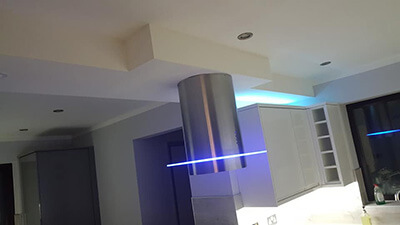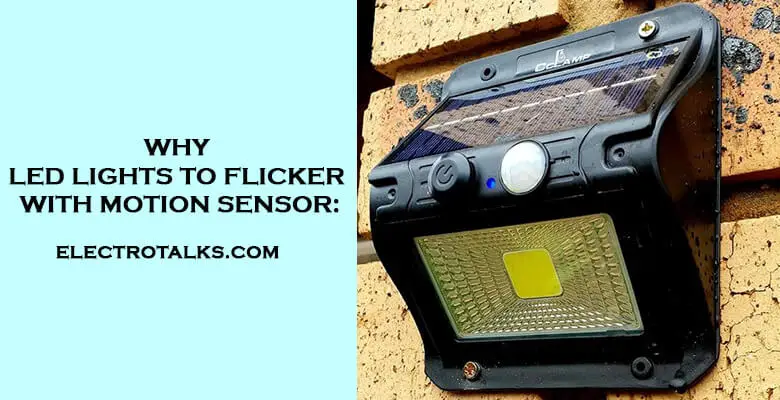“As an Amazon Associate, I earn from qualifying purchases. Without Any Extra Cost to You!”
Some motion detectors may be the source of a flickering LED lamp when they are connected. Typically, motion detectors with an electrical switch are to blame for this issue.
These require a specific minimum load for the electrical switch to operate without generating leakage currents.
To increase the overall safety and security of your home, motion sensors are used. Movement within a certain space causes motion sensors to be activated.
The two types of motion detectors reflect light when activity is detected and sound an alarm when movement is detected in a specific area.
Motion sensors can be installed indoors, outdoors, or in a combination of both.
This article includes the reasons why led lights flicker with motion sensors and how to avoid flickering. It also contains more information on whether led works with a motion sensor.
You will also find the frequently asked questions and their answers. Go through the article keenly to avoid missing the point.
Reasons why motion sensor lights flicker

The LED light may begin to flicker after you have switched to LEDs or after you have replaced a broken LED lamp. In some cases, the strength of the flickering effect can fluctuate in different situations.
However, in the majority of cases, it is extremely irritating and upsetting. To put an end to the flickering, it is necessary first to identify the source of the problem.
The most frequently seen error sources are those associated with dimmers, transformers, and faulty bulbs.
LED bulb flickering on a transformer
Low-voltage LED lamps are available in addition to the normal LED lights for the 120V power system. These are frequently used as low-voltage halogen light replacements.
The majority of low-voltage bulbs operate at a voltage of 12V. A transformer is responsible for generating this voltage from the electrical grid.
i. The output voltage quality
Low voltage LED bulbs to require an input voltage that is consistent and free of noise. The previous halogen lamps did not place such great demands on the quality of the transformer output as the newer fluorescent lamps do.
In some cases, a flickering LED transformer causes light with a dirty and variable output voltage.
It is necessary to replace old halogen transformers with fluctuating output voltages with LED power supplies since they are incompatible with LED lighting.
ii. Minimum load
Many electronic transformers are designed to work with a minimum of load when it comes to output side loads.
As per the Lumens to Watts’s converter, five LED illuminates with a combined output of 3W are sufficient to substitute five 20W halogen spotlights in a room.
A total of 100W of electrical power was required to run the old halogen lights across the entire installation.
A total of 15W is required to run the new LED lights throughout the entire installation. Nonetheless, likely, a 50-150W transformer from a previous installation is still in service today.
For this to function properly, it needs at least 50W. Aside from that, there will be no illumination or flickering from the linked lamps.
Flickering LED lights on the transformers indicate that the minimum load is much less. With the new LED lighting, you might now substitute one or two of the old ones.
In this case, the bare minimum load would be achieved, but this mixed functioning is not a particularly attractive solution.
Led lights flickering on a dimmer
LED lights are much more complex in terms of technology than older light sources. Especially important when you wish to reduce the brightness of the screen. A fully functioning LED bulb and dimmer are required to do this.
Many LED bulbs are not dimmer-compatible. The LED light must be marked dimmable at the time of purchase, and this must be done before purchasing the light.
The specs for the dimmer must also be compatible with the lighting. Older dimmers frequently require a large minimum load for proper operation.
Generally speaking, LED bulbs are not capable of achieving this.
To determine whether the LED lights are dimmable, check if the light is dimmable by turning on the dimmer.
This information must be included on the product package or in the product details to be considered accurate.
If a dimmable LED light source continues to flicker after being dimmed, the old dimmer is ineffective and must be changed with an LED dimmer, as described above.
Led lights flickering
It is the most difficult to troubleshoot an LED light if the flickering occurs only on rare occasions. It is possible that the occasional flickering is caused by one of the following factors:
I. The transformer used for low-voltage lights was not adequate.
ii. Unsuitable dimming mechanism
iii. The power supply in the lamp is faulty.
iv. The power grid is experiencing fluctuations.
If you have several comparable LED lamps put throughout your home, troubleshooting will be a lot simpler.
You may swap the lamps and observe if the periodic flickering now occurs with another lamp. If it does, you can replace the lamp.
As a result, the lamp will most likely be out of commission shortly. There can be a wide range of voltage variations in the electric grid.
To determine and rectify the actual reason, an electrician is required.
LED lights flicker when switched on.

The LED light may flicker for a short period after turning on because the lamp is of poor quality or will become faulty towards the end of its useful life.
The integrated power source is constructed from low-cost components to accommodate a large number of no-name bulbs.
Some of these require a specific temperature range before the flickering can be turned off completely.
If the flickering continues for a longer period day to day after being turned on, a problem in the LED light is gradually revealed.
Flickering is common with some low-cost LED bulbs after they have been turned on. This is due to substandard electronics, which results in the thermal inaccuracy already discussed.
However, if your lamp has been operating flawlessly for a lengthy period, a capacitor within the circuitry will most likely have lost its capacity.
If you suspect a loose contact, you can try the flickering Light Bulb in another lighting to rule out alternative possibilities.
Only replacing the old fluorescent lamp with a new LED lamp will be effective in eliminating the flickering upon switching on.
Flickering of lights when switched off
A LED bulb may flicker in some circumstances even when the light switch is switched off, which is not uncommon.
The electrical wiring is frequently to blame for this, and it is easy to figure out why. Flickering can be caused by a light switch that has been improperly connected or by a light switch that has a night light.
The specific backgrounds are the same as LED lamps that continue to glow after being turned off.
Led lights flickering on a motion detector.
Some motion detectors may be the source of a flickering LED lamp when they are connected. Typically, motion sensors with an electrical switch are to blame for this issue.
These require a specific minimum load for the electrical switch to operate without generating leakage currents. Single-wire motion sensors put into the phase line of the light are also a source of concern.
Flickering LED lamps on motion detectors are prevented by using a variation with a low minimum load or a switching relay.
Does LED work with motion sensors?
When it comes to motion detectors, LED bulbs are ideal. LEDs attain full brightness almost instantly after turning on and are built to withstand several switching cycles.
But first, double-check the motion detector’s settings. Many needless switching cycles are caused by incorrect or non-optimal settings, reducing the LED’s service life.
Because the lighting turns on and off every few minutes, a motion detector that isn’t set up correctly can be identified. It’s crucial to figure out the best brightness limit, sensitivity, and lighting time for you.
Frequently Asked Questions
Which motion sensor lights are the best?
On the top LED motion detector light list, Le-power is a reputable brand. It comes with two flexible heads and has two modes of operation: auto and test. ABS material is used to make the heads.
Although it is a solar-powered light, it does not require direct sunshine to recharge.
Conclusion
In conclusion, the sensor on most motion detector lights is easily adjusted. When it detects a large shift in the degree of heat within its vision, this sensor “trips.”
The sensor should be properly positioned and the settings suitable. If not, it could take up heat from places it shouldn’t. The angle range of each motion detection light sensor is different.
The majority of angle ranges are between 180 and 360 degrees. However, a sensor’s angle range can sometimes be too large, causing it to be activated by unnecessary movements, such as tree branches swaying.
To restrict the range of vision of your sensors, place tiny pieces of black tape on one or both sides. Always consider purchasing a high-quality motion sensor. This will save you a lot of problems.
